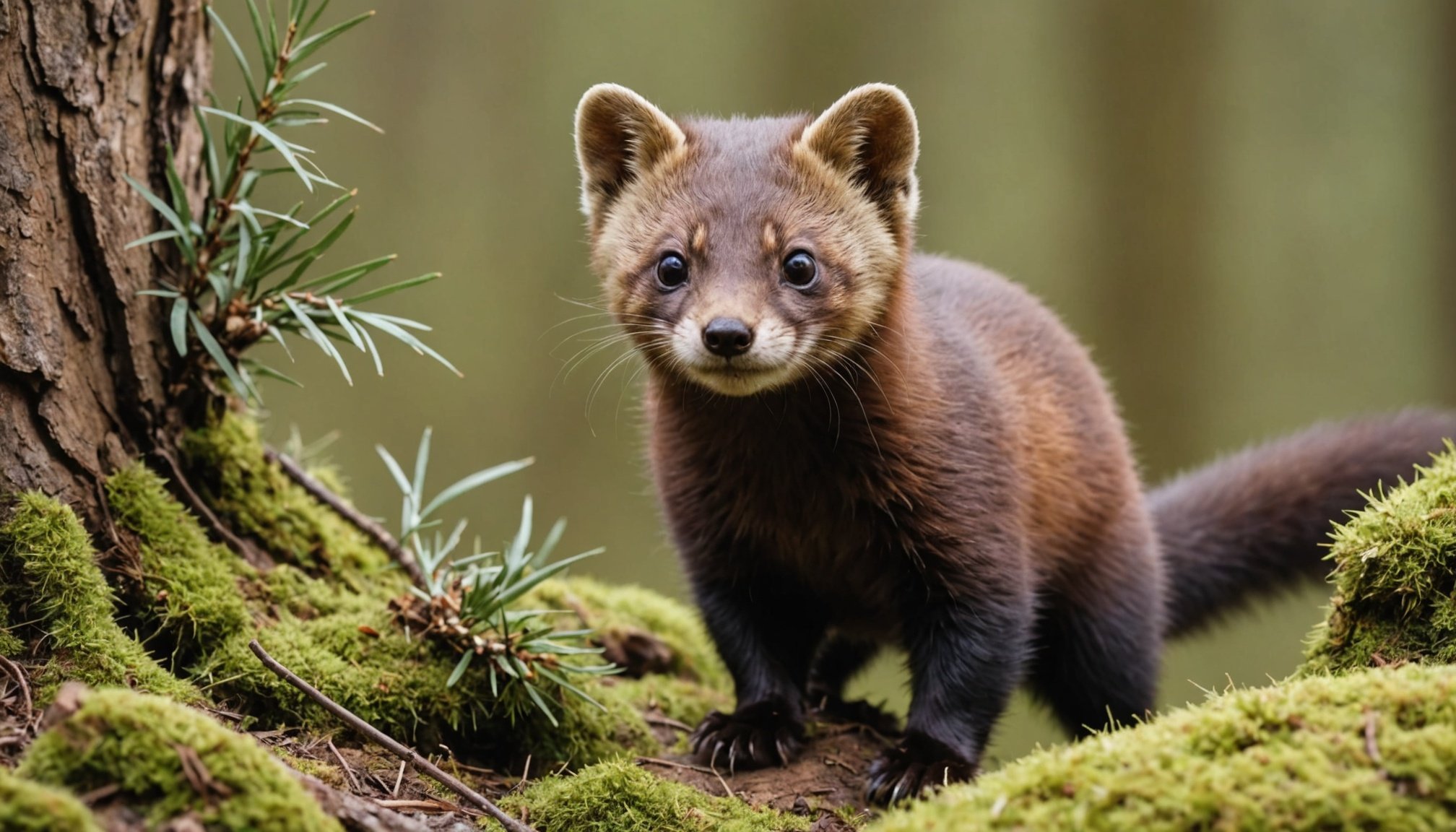Overview of Pine Martens and their Ecological Importance
The Pine marten, a nimble and solitary woodland mammal, plays a significant role in maintaining forest ecosystems. Their habitat requirements are diverse, primarily encompassing well-forested areas with an abundance of mature trees for denning and varied ground cover for hunting. Characterised by their lithe bodies and alertness, they are adept hunters.
In terms of their ecosystem role, pine martens effectively control rodent populations, which indirectly benefits woodland regeneration. As both predator and prey, they contribute to a dynamic balance in the forest environment. This predatory behavior influences the population dynamics of smaller mammals, impacting plant community structures by reducing seed predation.
In the same genre : Transforming British Urban Gardens: Cutting-Edge Solutions to Revive Endangered Pollinators
Their presence is vital for maintaining biodiversity within these habitats. A healthy population of pine martens often indicates a robust and diverse ecosystem. Declines in their numbers can lead to overpopulation of species lower on the food chain, disturbing ecological balance. As a result, conservation efforts focus heavily on maintaining and increasing pine marten populations to uphold wildlife diversity.
Their positive impact on ecosystems showcases the importance of biodiversity, driving home the critical need for continued conservation and habitat protection efforts to sustain these forest inhabitants.
Also to see : Sustainable boating in the uk: essential tips for safeguarding freshwater ecosystems and aquatic wildlife
Current Status of Pine Marten Populations in the UK
The conservation status of the UK pine marten population has become a pressing issue, with historical factors such as habitat loss and hunting contributing significantly to their decline. Once widespread across the UK, pine martens experienced a sharp decrease in numbers by the mid-20th century. This decline resulted in their classification as a threatened species, highlighting the critical need for conservation measures.
Presently, the distribution of pine martens remains uneven, with higher concentrations in Scotland compared to other parts of the UK. Ongoing threats, such as deforestation and illegal hunting, continue to pose challenges to their recovery. As a result, there have been significant efforts to assess and revitalise these populations, with various organisations involved.
Several conservation designations have been implemented to safeguard pine marten habitats. These include protected status for certain woodlands and restrictions on activities that could further disturb their environment. Monitoring programmes are crucial, providing data on population changes and informing adaptive management strategies.
Efforts to stabilise and increase pine marten numbers are vital. Investing in sustainable practices and enforcing protection laws can help secure a future for these vital components of the UK’s natural heritage.
Major Initiatives for Habitat Restoration
Efforts to restore pine marten habitats in the UK have seen notable advances, with several key projects spearheading the recovery of this crucial species. Collaboration is central to these endeavours, with government bodies, NGOs, and community groups working together to ensure the success of conservation initiatives.
One particularly ambitious project involves reforestation in targeted areas, providing the much-needed mature woodland cover for pine martens. These habitat restoration projects aim to create continuous wooded corridors that support biodiversity and facilitate population dispersal.
The methodologies deployed often include strategic planting of native tree species, which not only benefits pine martens but also enhances the ecological integrity of the area. Additionally, creating conservation corridors helps to reconnect fragmented habitats, increasing genetic diversity and reducing the risk of inbreeding within isolated pine marten populations.
Volunteer participation and local community involvement are crucial, contributing to both manpower and local interest in conservation aims. These efforts are augmented by educational platforms that propagate awareness about the importance of biodiversity and habitat restoration.
This multifaceted approach is critical, not just for the recovery of pine martens, but also for fostering resilient ecosystems that can support various wildlife species in the long term.
Ecological Impacts of Restoring Pine Marten Habitats
Restoring pine marten habitats carries profound ecosystem benefits, playing a pivotal role in ecological restoration. Pine martens help control prey species such as rodents, regulating their populations and indirectly supporting forest regeneration. As predators, they affect the availability of seeds and reduce competition among smaller mammals, fostering a rich and diverse plant community.
The restoration of these habitats not only benefits pine martens but also supports other wildlife species reliant on the same environmental conditions. By reinstating natural forest structures, these efforts promote an interconnected ecosystem, ensuring resilience and biodiversity. With the revival of forest corridors, animal migration and species dispersal opportunities are enhanced, contributing to genetic diversity.
Assessment of ecological changes following restoration projects shows promising results. Forest health improves through increased plant species richness and better wildlife habitat conditions. Other species, from insects to birds, find suitable environments to thrive, further enhancing the overall ecological balance. Monitoring these changes aids researchers in understanding the broader impacts of restoration, allowing for adaptive management that boosts conservation effectiveness.
Through these efforts, the benefits extend beyond pine martens, positively impacting the entire forest ecosystem and securing its longevity for future generations.
Community Involvement and Educational Outreach
Engaging local communities and fostering community engagement play a crucial role in pine marten conservation. Empowering people through active participation in habitat restoration strengthens conservation efforts. Volunteers contribute significantly by planting trees, monitoring habitats, and partaking in reforestation projects, bridging the gap between conservation experts and the community.
Conservation education forms another pillar of this approach. By using workshops, school programmes, and public talks, conservationists aim to build awareness about the importance of preserving pine martens and their habitats. These educational initiatives highlight the critical role of these mammals in promoting a healthy ecosystem, emphasising why their protection is essential.
Examples of successful community-led initiatives include local conservation groups that develop and distribute informative resources, fostering understanding and commitment amongst residents. These initiatives often inspire innovative solutions, such as creating marten-friendly environments in gardens or local spaces, increasing habitat connectivity.
By engaging the community in meaningful ways, these strategies not only support pine martens but also boost local pride and investment in the natural landscape. Facilitating educational outreach with practical and immersive experiences ensures that awareness permeates beyond conservation circles, fostering a broader cultural appreciation for wildlife protection.
Future Directions and Challenges in Conservation
As we look to the future of conservation efforts for pine martens, several trends and challenges emerge. Biodiversity policy will play a crucial role in shaping these strategies, ensuring that legislation keeps pace with ecological needs. The ongoing task is to balance human activities with the protection of natural habitats.
One significant challenge involves addressing the fragmentation of habitats, which impedes the natural dispersion of pine martens. Strategic efforts for habitat connectivity are essential, requiring collaboration between stakeholders and the implementation of coherent policies. Initiatives that promote sustainable land-use practices could mitigate these issues, enhancing environment-friendly planning.
Anticipated advancements in technology could revolutionise conservation practices. Remote sensing and DNA analysis are promising tools that could refine monitoring techniques and offer deeper insights into pine marten behavior and ecology. However, reliance on technology requires training, funding, and continuous updates to remain effective.
The evolving landscape of conservation policy underscores its importance. Future policies may more strongly advocate for proactive conservation, setting a precedent for practices that preemptively address threats rather than reacting to them. Balancing economic interests and environmental sustainability will remain a delicate task, demanding creative solutions and adaptable frameworks to protect these vital ecosystems.
Case Studies of Successful Pine Marten Restoration Projects
Several successful projects have demonstrated the effectiveness of focused restoration initiatives for pine martens in the UK. One notable example is the reintroduction in mid-Wales, a project led by Vincent Wildlife Trust. This initiative saw the translocation of pine martens from Scotland to Wales, aiming to re-establish a viable population in areas from which they had disappeared. The project excelled through meticulous planning and local community engagement, ensuring coexistence between humans and these elusive creatures.
Key lessons learned underscore the importance of habitat connectivity and local stakeholder involvement. Ensuring appropriate habitat corridors helped the new populations disperse naturally, fostering genetic diversity essential for long-term survival. Moreover, the project’s success was fuelled by educational workshops that cultivated public support and awareness.
Testimonials from conservationists involved reveal the profound impact of collaborative efforts. As one participant noted, the project not only revived pine marten numbers but also strengthened community ties and appreciation for ecological preservation. These insights can be instrumental for similar projects elsewhere, proving that well-coordinated, informed, and inclusive efforts can yield enduring conservation successes. By adopting these practices, further strides in supporting biodiversity and ecological harmony can be achieved.











